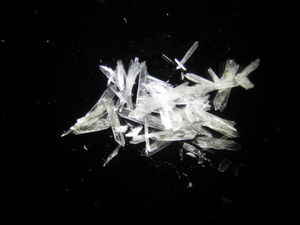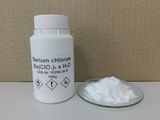Barium chlorate
 Crystals of barium chlorate
| |
| Names | |
|---|---|
| IUPAC name
Barium chlorate
| |
| Other names
Barium dichlorate
Chloric acid, barium salt | |
| Identifiers | |
| Jmol-3D images | Image |
| |
| Properties | |
| Ba(ClO3)2 | |
| Molar mass | 304.23 g/mol |
| Appearance | White solid |
| Odor | Odorless |
| Density | 3.18 g/cm3 |
| Melting point | 413.9 °C (777.0 °F; 687.0 K) (decomposes) |
| Boiling point | Decomposes |
| 27.5 g/100 ml (20 °C) 37.9 g/ 100 ml (25 °C) | |
| Solubility | Slightly soluble in acetone, ethanol, methanol |
| Vapor pressure | ~0 mmHg |
| Hazards | |
| Safety data sheet | Sigma-Aldrich (monohydrate) |
| Flash point | Non-flammable |
| Related compounds | |
| Related compounds
|
Barium chloride Barium perchlorate |
| Except where otherwise noted, data are given for materials in their standard state (at 25 °C [77 °F], 100 kPa). | |
| Infobox references | |
Barium chlorate is the inorganic chemical compound with the formula Ba(ClO3)2 and is the barium salt of chloric acid. It is a strong oxidizing agent.
Contents
Properties
Chemical
Barium chlorate is an extremely powerful oxidizer.
If sulfuric acid is added to barium chlorate, chloric acid is formed:
- Ba(ClO3)2 + H2SO4 → 2 HClO3 + BaSO4 ↓
Since barium sulfate is very insoluble, this reaction is useful to obtain chloric acid of high purity: just filter the solution.
If the experiment is run dry (i.e. in a non-aqueous environment), the pure, very unstable chloric acid decomposes immediately to perchloric acid and chlorine dioxide. The latter will spontaneously ignite any combustible material (sugar, paper, dust). However, doing this reaction in water lets one synthesize stable solutions of chloric acid.
Barium chlorate always gives the green color to the flame if it is a component of a fuel-oxidizer mix. This is its main use in pyrotechnics.
Physical
Barium chlorate is a transparent to white salt that is poorly soluble in water and glycerol.
Availability
Barium chlorate can be bought from chemical suppliers and online.
It can also be found in some pyrotechnics.
Preparation
A very simple route to obtain barium chlorate involves mixing sodium chlorate and barium chloride in solution and then letting it crystallize.
- 2 NaClO3 + BaCl2 → Ba(ClO3)2 + 2 NaCl
Barium chlorate is the least soluble and crystallizes first - it has a decent solubility though and several recrystallizations may be needed to remove all traces of sodium.[1]
However, while the reaction is simple, the final product may be contaminated with sodium ions, and while this may not be a problem for most reactions, it makes the product unsuitable for flash powders, as the Na ions will color barium's green flame into yellow. Sodium-free routes are thus required:
Electrolysis of aq. solutions of barium chloride will yield barium chlorate. Barium chlorate however, is more soluble in water than its chloride. Thus, the product will not precipitate out of the solution and has to be separated.[2]
The common precursor chemical to barium chlorate is potassium chlorate, in form of the warm solution. You will also need ammonia and tartric acid. Bubble ammonia through a solution of tartaric acid until you get ammonium tartrate, or mix aqueous ammonia (fresh, so you know the concentration) with tartric acid. Add both solutions to barium carbonate and boil until ammonia and carbon dioxide stop emerging. You will notice that the insoluble, chalky barium carbonate dissolves. Ammonia will emerge and briefly liberate chloric acid, which will react with barium carbonate; the insoluble potassium bitartrate will precipitate.
- BaCO3 + 2 (NH4)2C6H2O6 + 2 KClO3 → Ba(ClO3)2 + H2O + CO2(gas) + 2 KHC6H2O6(prec.) + 4NH3(gas)
The same synthesis can be done with any other acid with a soluble ammonium salt and an insoluble potassium salt, such as hexanitritocobaltic. But tartric is just cheaper.
Do not use barium hydroxide, it will lead to an undesirable side reaction: formation of barium tartrate!
Alternatively, when both solutions of potassium chlorate and and ammonium bitartrate are mixed, the rather poorly soluble potassium bitartrate can be removed by filtration before continuing.[3]
Lastly, addition of chloric acid to barium carbonate or hydroxide will give barium chlorate.
- 2 HClO3 + BaCO3 → Ba(ClO3)2 + H2O + CO2
- 2 HClO3 + Ba(OH)2 → Ba(ClO3)2 + 2 H2O
Projects
- Green fireworks
- Chloric acid and perchloric acid synthesis
Handling
Safety
When mixed with combustible materials, even those normally slightly flammable (such as dust and lint), it will burn vigorously in combination and the fires are extremely hard to put out, as the chlorate provides the oxygen for the fire. Sulfur and red phosphorus, should be avoided in pyrotechnic compositions containing barium chlorate, as well as any acidic salts, as these mixtures are shock and friction sensitive and prone to spontaneous deflagration (in the safety head matches, such mixture is stabilized with glue).
Like all soluble barium compounds, this one is acutely toxic if ingested!
Storage
Barium chlorate should be stored in closed containers and away from any organic sources, as well as strong acidic vapors. Since it is not hygroscopic, it is not necessary to keep it air tight.
Disposal
Barium chlorate can be neutralized in two steps. First, with a reducing agent, such as sodium metabisulfite, sodium bisulfite, sodium sulfite. Then, the toxic barium remains, and this is neutralized with sulfuric acid. Using sulfites allows combining both steps, since they oxidize to sulfates and neutralize barium in their oxidized form.
Gallery
References
- ↑ https://illumina-chemie.de/bariumchlorat-t4340.html
- ↑ http://www.chlorates.exrockets.com/barium.html
- ↑ This page recommends barium hydroxide. I have found little success with barium carbonate (Source: personal experience by Diachrynic). http://www.chlorates.exrockets.com/barium.html
Relevant Sciencemadness threads
- Chemical pages without CAS Registry Number
- Articles without EBI source
- Chemical pages without ChemSpiderID
- Chemical pages without DrugBank identifier
- Articles without KEGG source
- Articles without InChI source
- Articles without UNII source
- Articles containing unverified chemical infoboxes
- Chemical compounds
- Inorganic compounds
- Barium compounds
- Chlorates
- Oxidizing agents
